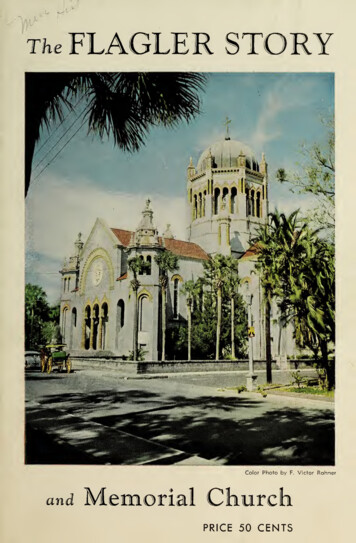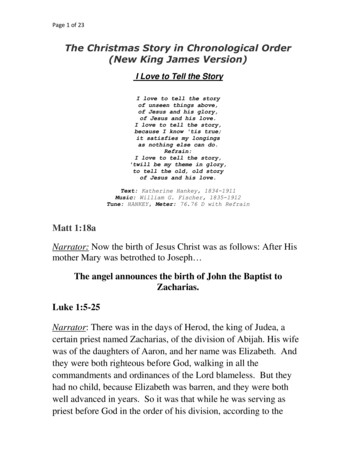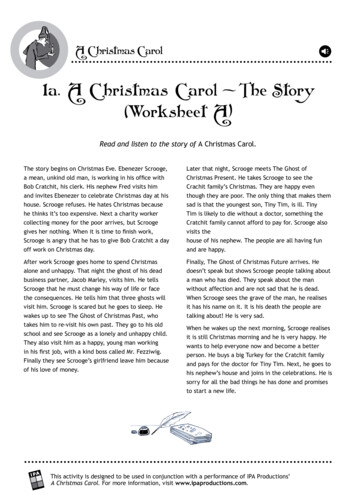
Transcription
TheFLAGLER STORYColor Photo by F. Victor RahnerandMemorial ChurchPRICE 50 CENTS
Portrait of Henry M. FlaglerHangs in Ponce de Leon Hotel, St. Augustine.
JIlSLfLflGLER STOfiyandmflDORIfll CHURCHBy the Rev. Howard Lee, D.D.Copyright 1949byMEMORIAL PRESBYTERIAN CHURCH SOCIETY(a corporation)Saint Augustine, Florida.The Record Press, Inc., St. Augustine, FloridaFirst Printing, December 1949Second Printing, May, 1951Third Printing, May, 1953Fourth Printing, July, 1954Fifth Printing, November, 1955Sixth Printing, March, 1957Seventh Printing, July, 1958Eighth Printing, July, 1959
JhsLFLAGLER STORYThe amazing career of HenryMorrison Flagler has made theman a legendary figure. TheFlorida visitor hears many con fusing stories of the empirebuilder. Some picture him asa saint; others represent himas just the opposite. Actuallyhe was neither. All men are acomposite of good and evil; soHenry M. Flagler, being a man,shared something of the samemixture in his own being.It is the purpose of this bookto present, in outline, the prin cipal facts of his life, allowingthem to speak for themselves.The Florida visitor, armed withthese facts, will be enabled toevaluate the Flagler stories tobe heard and read on histravels.Statue of Henry M. Flaglerin station park, St. Augustine.WHO WAS FLAGLER?The tourist has occasion to ask this question often, for theFlagler name appears from one end of the state to the other.And no wonder. He was the pioneer developer who, more thanany other one man, saw the vision of what the young andundeveloped state, with its unrivalled climate and rich naturalbeauty, might become. Having seen this vision, he invested more ofhis own money than any other person in bringing the vision to reality.He built hotels, roads, bridges, and railroads. Those in turn broughtother men of wealth to the state.Wherever Flagler and hisenterprises went new communities sprang up, industry and agri culture developed. As you ride over Florida's smooth roads, enjoyits fine resorts, or do business in its modern cities, you will knowthat Henry M. Flagler, son of a Presbyterian minister, partner ofJohn D. Rockefeller in the Standard Oil Company, was the manwho, more than any other, made possible the modern tourist trekto "America's Riviera''.
HIS EARLY LIFEHenry Morrison Flagler was bom in Hopewell, New York. Hisfather, The Rev. Isaac Flagler, was minister of the PresbyterianChurch.It was a small, rural congregation and the ministerfarmed during the week in order to support the family. As youngHenry grew to manhood his father attempted to guide him intothe same kind of life, combining the ministry with farming. Henryhad his own ideas. Frustrated by the poverty he shared in theminister's home, he early promised himself to become a rich manand escape the limitations of poverty. His first step toward hisambition was his leaving home at the age of fourteen for thewest; he worked his way by canal and lake boat to the WesternReserve in northern Ohio. Here among relatives of his motherhe took his first job in the store of L. G. Harkness and Companyin the town of Republic. He worked six long days a week; hissalary was 5.00 a month and board and room. He won the fullconfidence of his relatives there and learned from them his principlesof industry, thrift, and enterprise. These relatives were themselvesmen of expanding fortunes and young Flagler expanded with them.First he became manager of the store where he had begun, thenhe was made manager of a grain company organized by the family,his success was so marked that he was soon welcomed as a partnerin the firm. By the time he was twenty-two, only eight years after hehad arrived in Ohio with only a few pennies to his name, he wasa full partner in a prosperous grain business, with several thousanddollars saved up, and was looking toward his marriage to MaryHarkness, daughter of the man who was his first employer. Thismarriage, which was welcomed by all the family, took place inBellevue, Ohio, November 9th, 1853.BUSINESS SUCCESSThe story thus far is the usual American success story: a virtuous,hard-working lad, starting with nothing works his way up to owner ship, prosperity and marries the boss' daughter.But Henry Flagler tasted failure, too. In the early 1860's saltwas discovered in Michigan, and many companies were beingformed to produce this commodity much in demand due to theCivil War. Fortunes were being made in salt, and Henry Flagler,with 50,000 earned in his grain dealings, leaped in that direction.He formed a company in Saginaw, Michigan, investing all hissavings, and began producing salt.Everybody seemed to behaving the same idea, and before long failures became numerous.Flagler found that experienced producers had the advantage overhim. After about two or three years of earnest effort, he gaveit up when the salt prices fell at the close of the war, having losteverything he had and ending up badly in debt.
He did not tarry long over this failure. Marking well the lessonsit held, Henry Flagler borrowed enough money to pay his debtsin Michigan, and moved to the flourishing young city of Cleveland,Ohio, to try again.Before long he had re-established himselfin the grain business and was steadily making up his losses.A significant detail is his meeting again at this time a youngman with whom he had earlier had dealings in the grain business—John D. Rockefeller. They became close friends and, as bothwere ambitious to be wealthy, they found great pleasure in eachother's company. When Rockefeller needed new capital and newimaginative leadership in his oil company, he turned naturallyto Flagler. Flagler easily found the capital and there was formeda partnership that was to result in one of America's great industrialempires and millions of dollars for its founders.The companywas known as Rockefeller, Andrews, arid Flagler. The years ofclose collaboration between Rockefeller and Flagler resulted eventu ally in the Standard Oil Company. Rockefeller said years laterthat the idea of the Standard Oil combine was born in the mindof Henry Flagler.The phenomenal growth of the oil business at this period hadmuch to do with the Flagler success. At a time when more andmore uses were being found for oil, Flagler was fortunate enoughto be in the oil business.Add to that the ambition and theenterprise of both Flagler and Rockefeller and the results wereonly natural. The story of the questionable methods employedby many industries, railroads, and businesses to gain predominancein that era has been told often enough. The Standard Oil Companygained its position of preeminence by methods common in businessat the time but since outlawed, practices that cannot be condonedby the ethical standards of our time. But this book is a record,not a judgment.The Flagler fortune grew with the oil industry and with thedevelopment of the Standard Oil Company. By 1877, ten yearsafter his entrance into the oil business, Henry Flagler was alreadya rich man, but his fortune was only begun. In this year he movedwith his family to New York City, the better to represent thegrowing company of which he was secretary and treasurer. InNew York he soon won a respected place among the most pro gressive bankers and business executives. His boyhood ambitionto be rich was achieved.FLORIDA "EMPIRE BUILDER"Henry Flagler's first visit to Florida was in the winter of 1878-9.His wife, Mary Harkness, had never been of robust health; shehad borne three children. Jennie Louise was now a young marriedwoman of twenty-four years; Carrie had died as a child; the sonHarry was eight. Mrs. Flagler's health became decidedly worseand the doctors advised that she spend the winter in Florida, wherethe sunshine and fresh sea air might work their healing. Mr. Flagler
took the entire family to Florida. They stayed in Jacksonville, whereaccommodations were poor enough; farther south there were norailroads, and few roads or hotels to serve the traveller. In Florida,Mrs. Flagler's condition improved noticeably, but Mr. Flagler grewrestless away from the affairs of his business and made plansto return; he wanted his wife to remain, but she would not stayon without him. The following winter he urged Mrs. Flagler toreturn to Florida by herself, but she refused to go without herhusband and children. Mr. Flagler felt that he could not sparethe time from the business, where his efforts were piling up millions.It was not long before he realized that his wife's condition wascritical. Then he tried to arrange the trip, but it was too late.He could only stand by and wait for her death, which cameMay 18th, 1881.Henry Flagler was stricken by his wife's passing. Their com panionship had been warm and intimate for the twenty-eight yearsof their happy married life.Flagler, like many another beforeand since, understood then that riches in themselves do not bringhappiness.The person he loved most was gone; the millionshe had given his thought and energy to accumulate were a poorsubstitute. This great sorrow wrought a deep change in Flagler;from that time he began to take a belated interest in mattersother than business and money. Home, family, cultural interestswere given a larger share of his attention. He realized, too, thatthe business organization of the Standard Oil Company had(largely by his own energy and imagination) been perfected andthat its work could now be carried by others, consequently hespent less and less time in the active work of the company. He re mained a vice-president, a director, and one of the largest stock holders for many years, but his sorrow had taught him that therewas more to life than the making of money.The next visit Mr. Flagler made to Florida was in December,1883, when he and his new bride came first to Jacksonville and thento St. Augustine by way of the St. Johns River and the Tocoi railway.They found St. Augustine much to their liking and extended theirstay through the winter. The ancient Spanish fortress-town, withits old world atmosphere and sunny climate was little known to thepublic; there were few hotels or other accommodations to attractvisitors. Mr. Flagler saw the possibilities of St. Augustine as amecca for honeymooners and sun-loving winter visitors. He wasback again the next winter and dreams of fulfilling another boyhoodambition began to take shape. As a lad his hope was to becomean innkeeper. What now was to keep him from realizing this hope?He was worth millions; his business was bringing him more wealthdaily. Here in Florida was a tropical paradise to be developedand publicized. If visitors were to come and enjoy the salubriouswinter sunshine there must be modern, comfortable hotels to wel come them. With that boyhood dream reborn in his mind, a newadventure had begun for Henry Flagler.
*Front view of the Hotel Ponce de Leon from across King Street.The Dome of Memorial Church at left.In March, 1885, St. Augustine celebrated the landing of Poncede Leon; it was quite a show and a record number of wintervisitors were in the city that season. Flagler was so impressedby the pageant that he determined to build a great luxury hotelin keeping with the traditions of the old Spanish city and to nameit after Florida's discoverer, Ponce de Leon.He engaged ThomasHastings, a promising young architect, in the firm of Carrere andHastings, of New York, to draw up plans for it. Hastings alsowas a son of a Presbyterian minister; Flagler was a close friendof the father. The architects gave their best efforts to the projectand from their work in Florida their firm gained a national repu tation. Among other noted buildings Carrere and Hastings de signed are the New York Public Library, the Metropolitan Opera(interior), the United States Senate Office Building in Washington,and the Memorial Amphitheatre in the National Cemetery at Ar lington, Virginia.The Ponce de Leon Hotel was formally opened to the publicwith a gala celebration January 10th, 1888.It was reputed atthe time to be the finest hotel in the world. Built at a cost of twoand a half million dollars, this palatial structure, with its Span ish inner-court surrounded by gracious verandas and dominatedby towers that rise high above the town, immediately attractedthe wealthy, the famous and the great of that day. St. Augustinebecame famous as a restful resort abounding in historic remindersof Spain's lost empire and savoring of far-away lands. By today'sstandards the Ponce de Leon Hotel is considered quite "fancy".But it remains one of the wonders of hotel architecture and attractseach winter a discriminating clientele.
Mr. Flagler added two more hotels to his St. Augustine enter prises, the Alcazar and the Cordova, which opened the sameseason as the Ponce de Leon.The problem of transportationalso attracted his attention at this period; if building materialsin such huge quantities were to arrive on schedule and travellersto come in comfort, dependable rail service must be established.There was a little railroad between Jacksonville and St. Augustine;it was described as "a streak of rust and a right of way." It ishardly likely that Flagler intended at the outset to get into rail roading, but he bought this little road, and from that time onhis railroad and his hotels worked hand in hand, the efficiencyof one complimenting the service of the other.The popularity of Flagler's St. Augustine developments showedhim the tremendous possibilities of expansion in Florida. Withthe urge to achieve strong within him, it was only a matter oftime until rails of steel were pushed southward to serve otherluxury hotels; first Ormond, then Palm Beach, then Miami at theend of the peninsula. But the Flagler imagination leaped acrossthe Keys and to the Bahamas; before he was finished he hadtaken his railroad "to sea", extending the line across the Keys,clear to Key West.A steamship line was also established toserve two more Flagler Hotels at Nassau.Beginning with thethought of building one good hotel in St. Augustine, he endedwith 642 miles of Florida East Coast Railway and a great systemof luxury hotels from Jacksonville to the Bahamas.
BUILDER OF COMMUNITIESThe Flagler contributions to the rise of modern Florida shouldnot be thought of merely as the building of resorts.Flagler'sinterest was always centered in the making of communities, thedevelopment of agriculture, and the encouragement of industry.When a new town was started, work on a school and a churchwas begun at the same time as the railroad station.A writer of that era gave this evaluation:"The hotels, winter resorts and the railroad were the outstandingfeatures of the Flagler program of development in Florida. Theywere the things that attracted most attention and brought peopleof wealth to the state. More important in the long run, however,has been the domestic development of Florida which resultedfrom these Flagler enterprises. Agriculture and industry invariablyfollowed each extension of the railroad and resorts. Mr. Flaglermade extensive land purchases within reach of his railroads andsold tracts to settlers; citrus groves and vegetable farms hadaccess now to the winter markets of the north via the Flaglerrailway system."Perhaps the most illustrative example of Flagler's service tothe state through community development is that of the city ofMiami.Until 1896 it was only a wilderness trading post, witha few scattered settlers living in the area. Among those pioneersettlers was Mrs. Julia D. Tuttle, who had a vision of what thatpart of the state might become. Until "the big freeze" of 1894-5,
she was unable to capture the interest of any developer; but inthat year of tragedy, when the Arctic sent its icy fingers downinto an unsuspecting and unprepared Florida, the fruit and vege table crops of hundreds of settlers in north and central partsof the state were wiped out. Public morale was shaken; settlersbegan deserting their homesteads and returning to the Northdiscouraged and beaten. Many predicted that the end had comefor Florida as a citrus-fruit and winter-vegetable growing state.This gave Mrs. Tuttle the occasion to appeal to Flagler; Miamihad not been hit by the freeze, growers would be safe in thatarea.If Flagler would extend the railroad into this area, theagriculture of the state could be saved. Flagler made a personalsurvey that very year, caught the vision of Mrs. Tuttle, and madeplans straight way for the extension of the railway and the de velopment of a town. The first trains began running into Miamiearly in 1896; it was a costly development for Flagler, but peoplebegan to pour into the new community, and he was not satisfieduntil he had donated land for a public school and contributedmoney for its construction. He also gave land for churches ofthe several denominations and helped to erect houses of worshipfor congregations of Baptists, Methodists, Episcopalians, Presby terians and Roman Catholics.He provided land for municipalbuildings, a city market, and public parks. Flagler, always inter ested in families and homes, helped many settlers who had beenfrozen out to reestablish themselves and build homes.The city of Miami, largest in the state today, owes its birthand development, as do so many other communities in Florida,to the vision, generosity, and public spirit of Henry M. Flagler.Flagler Memorial Monumentlocated on an island inBiscayne Bay, Miami.
The Sanctuary of Memorial Church.FLAGLER—THE CHURCHMANThough Henry Flagler revolted against the poverty he had knownin "the manse/' he never had anything but affection for his ministerfather and devout mother. And though he left his home at onlyfourteen, he took with him the habits of worship and prayerhe had learned there.He was a Presbyterian by upbringingand conviction, and it is recorded that even from his earliest daysaway from home he established habits of regular church attendance.In Ohio he associated himself with the Congregational church,as no Presbyterian church was in his town in Ohio. Likewise inSaginaw, Michigan, the young enterpriser in the salt manufac-
turing business, along with his wife, was a member and regularattendant of the First Congregational Church.The records ofthat church show that he was superintendent of the Sunday Schoolalso. In Cleveland he and his family were affiliated with the OldStone Presbyterian Church; here, too, he taught in the SundaySchool.These habits of faithful church attendance continuedthroughout his life, and among his closest friends were manyministers.Flagler was a generous supporter of all churches. Though hewas a Presbyterian, his gifts and interests were not confined toany one denomination. As already stated, he helped churchesof the several faiths to acquire favorable sites and build housesof worship.In Palm Beach he provided an undenominationalchurch, Poinciana Chapel, to serve the winter visitors. Mr. Flaglerhimself worshipped there in his latter days when he made hishome in Palm Beach.In St. Augustine he erected the Grace Methodist church, a fineSpanish design, and gave it to the congregation in exchange fora small lot they owned.Through his generosity the CatholicCathedral in St. Augustine was rebuilt and the Baptist churcherected. To the end of his life he aided many churches, largeand small, with his generous contributions.The outstanding evidence of his churchmanship undoubtedlyis the inspiring Memorial Presbyterian Church in St. Augustine.The impressive story of this church is told in the latter part ofthis book.Flagler's personal life bore evidence of his Christian convictions.For example, in his early business career, the grain firm in whichhe was a partner, had branched out into the distillery business.This was in the 1850's, long before the temperance movement hadarisen, and the whiskey business was thought entirely respectable.But Henry Flagler had been taught by his minister father the evilsof the liquor traffic. He was not comfortable as a partner in thatbusiness and welcomed the opportunity to withdraw from it. Hewas personally an abstainer from alcohol and lost no opportunityto discourage its use.Men who worked closely with him, report that in all their yearsin his company they never heard him use anything but cleanlanguage. Profanity was no part of the man. Though he sufferedblunders from many of his associates and employees, he wasnoted for his quiet self-control and his kindness and considerationtoward others.Another example of his religion in action is his generosity towardpeople in need. It was not easy to discover where his hand hadhelped; he preferred to remain anonymous. One story is told thathe handed the Rev. Dr. John R. Paxton, his New York pastor, acheck for 100,000 on one New Year's day, a holiday gift forcharity. The pastor might use it at his discretion, the only conditionbeing that no one should know the source of the gift.
During one of the big freezes in Florida, in the nineties, Flaglerdispatched one of his trusted employees to the blighted area withorders to spend 200,000 (and more if necessary) to help thesuffering, saying, "I would rather lose it all, and more, than tohave one man, woman or child starve."Modesty was another virtue of Henry Flagler. One of his em ployees, who knew him well, once said, "I should say that heis the most modest man in the world," and then related how thepeople clamored to change the name of Miami to Flagler, butFlagler himself would not permit it.Another evidence of thissurprising modesty, is the fact that the officers of Memorial churchwere forced to wait until a meeting when he was not presentin order to vote to Flagler his favorite pew (#20) in perpetuity.Flagler's hard work and tremendous expenditures in Florida,when he might have comfortably retired, sprang from his religiousprinciples.True to his Calvinist upbringing, he believed inwork as a virtue. To the end of his active life he worked sixfull days a week.Another Calvinist belief is that wealth is atrust from God, and a man of wealth is but a steward, a trustee;the wealth belonging actually to God, the steward is obligatedto use it to the glory of God and the good of men. Thus Flaglersaw Florida as the opportunity to use the great wealth that hadbeen entrusted to him in helping others."I have come to theconclusion," Flagler once said, "that the best way to help othersis to help them to help themselves." This he did in Florida. Open ing the state for recuperation and recreation, he opened the wayfor settlement and cultivation of the land.Profit was not hismotive; he already had more millions than he could spend, andfew of his ventures held promise of paying a return. The railroad,for example, on which he spent many millions to the benefit ofthe state, returned little if any profit to him.Near the end of his days, Flagler said to a friend, "If it wasn'tfor Florida, I'd be quite a rich man today." Indeed he might wellhave been "rich as Rockefeller" except for his liberal investmentsin Florida, "helping others to help themselves."To point to these characteristics is not to argue his perfection.Henry M. Flagler had faults and sins, as all men have. But thereligion he learned in the Christian home of his childhood was aguiding light through the many chances and changes of a greatcareer and drew him always to the fellowship of the Church andto Him who is the Saviour of all."TRIBULATION AND ANGUISH"Henry Flagler suffered deep sorrow in the loss of his belovedwife, the mother of his children, Mary Harkness. His secondmarriage, two years later, to Ida Alice Shourds in New York, wasdestined to bring tragedy and sorrow. There was a great differencein social background, personal tastes and age between them. Flag ler was a man of little formal education but of great refinement
and charm; through reading and personal contacts he gained con siderable learning and culture. Alice was unable to cultivate thequiet social graces her husband carried so naturally. She likedexcitement and activity; Mr. Flagler preferred intellectual pursuits.For all that, Flagler gave every evidence of loving his wifeAlice and strove to make her happy.He had a private rail road car built for their travels and named it "Alicia" for her,likewise a fine yacht was christened with the same name. Hebuilt a hospital in St. Augustine and named it for her. He madeno objections to her extravagant expenditures and occasionallysurprising conduct. But within ten years of their wedding it becameapparent that Alice was becoming something more than merely"peculiar".She began having the wildest delusions, claiming that theCzar of Russia was secretly in love with her and that she hadcommunications with him through the Ouija board. The counselof the best doctors and specialists in mental disease was enlisted,but to no avail. Except for one or two brief intervals, she grewprogressively worse, and was, after all else had failed, committedto the insane asylum. Within a few years her state had so faradvanced that all hope for a recovery was given up, and shewas pronounced by clinic and court incurably insane. With hermind entirely gone, there was no longer any means of communi cation between them, and Mr. Flagler never saw Alice again afterher final commitment in 1897.Another great sorrow had befallen the wealthy Flagler, andmoney had no power over it. He provided every possible comfortand care for his deranged wife, even settling a large sum on herprivate estate, which at her death at the age of eighty-two in 1930amounted to 15,000,000.After several years of loneliness, Flagler sought a divorce. Hislegal home had been in New York, where the law did not allowdivorce on the ground of insanity; nor did the law of his adoptedstate. But Flagler had many influential friends, and in consultationwith them, it was suggested that the Florida law might be changed.Consequently, a bill was introduced in the state legislature pro posing to make incurable insanity a ground for divorce. It becamelaw on April 25th, 1901. The Flagler divorce was granted August13th, 1901.Today, when easy divorces on the flimsiest grounds are quicklygranted in several states, it is difficult to see how this actionwould have caused more than passing comment. As a matterof fact, it precipitated a public scandal and brought an avalancheof criticism and vilification down upon Flagler.On August 24th, 1901, he married Mary Lily Kenan in Kenansville, North Carolina. One often hears the statement that Flagler'sdivorce law was repealed the day following his divorce; likemany such stories, this is entirely false. Actually the law remainedon the books for several years, being repealed in 1905.
“Kirkside”The Flagler Mansionin St. AugustineDemolished in 1951LAST DAYSIn St. Augustine Flagler had erected a line home, "Kirkside,"next to Memorial Church; it was designed in good taste, GeorgianColonial in style.Following his marriage to Mary Lily Kenan he built anotherhome in Palm Beach. "Whitehall" was a lavish marble palace,in keeping with the desires of his new wife. To the end of hislife, ten years later, he called this his home. But, although hehad spent more than two and a half millions in building it, andhad brought its furnishings and art treasures from the far cornersof the earth, the aging millionaire found little real happiness there.Mrs. Flagler, a woman of charm and talent, established herselfas an arbiter of society and fashion; she entertained the elite inan elaborate manner. The crowds of people began to tire Flagler,and gradually these big affairs were given up; Mrs. Flagler centeredher social life outside her home and only a few close friends wereguests at Whitehall.Flagler had still one great ambition; he desired above every thing to live to see the completion of his overseas railroad toKey West. Engineers said it couldn't be done; people generallywondered why anyone would want to do it. They called it "Flag ler's Folly,'' but Flagler had his own reasons for the project andthey satisfied him. He did live to see his favored project completedat a cost of 20,000,000. This brought his Florida expendituresbeyond 50,000,000, and made his railroad connect his enterprisesfrom one end of Florida to the other.On January 22nd, 1912,shortly after his eighty-second birthday, Henry M. Flagler rodethe first train over the "extension" spanning miles of open sea,
across the islands to Key West. A mammoth celebration was heldthere in his honor. The railway operated trains over this routefor more than twenty years, though it was never a profitable run.In 1935 a disastrous hurricane so damaged the road that its oper ation had to be suspended; now it has been converted into theOverseas Highway that bears auto traffic to the southernmostcity in the United States.His earthly ambitions achieved, Flagler lived little more than ayear. He passed from this life at the age of eighty-three on themorning of May 20th, 1913, in Palm Beach. His estate was valuedat 100,000,000. He was returned for burial to St. Augustine, ac cording to his wishes. St. Augustine had been his "first love" inFlorida and remained uppermost in his affections. Here he hadbuilt the now-famed Memorial church; adjoining it was the mau soleum where his first wife, Mary Harkness, and their daughter,Jennie Louise, and her baby, slept. Here, beside them at MemorialChurch, Henry M. Flagler was laid to rest.Flagler arriving on the first traininto Key West.imtAAA train on the “Railroad that Went to Sea.*9
THE FLAGLER STORYAt a Glance1830—Henry Morrison Flagler bom January 2, 1830, in the Presby terian Manse at Hopewell, New York, son of the ReverendIsaac and Elizabeth Caldwell Flagler.1844—Young Flagler left home to seek his fortune in Northern Ohio.1844—Arrived Republic, Ohio, with one nickel, four cents, and aFrench coin as his total capital. Began working in the storeof L. G. Harkness and Company at a salary of 5.00 per monthand his keep.1849—Moved to Bellevue, Ohio, and a new job in the grain bus
empires and millions of dollars for its founders. The company was known as Rockefeller, Andrews, arid Flagler. The years of close collaboration between Rockefeller and Flagler resulted eventu ally in the Standard Oil Company. Rockefeller said years later that the idea of the Standard Oi










